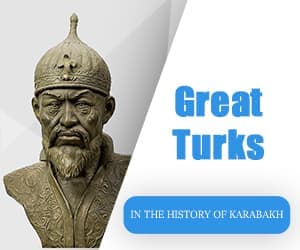After execution the mass genocide of Azerbaijanis in the Baku province (March-April 1918) by Baku Council of People’s Commissars, headed by the Bolshevik Stepan Shahumyan and the Dashnak armed forces, the Baku Council, together with the Karabakh Armenians, was going to attack Ganja and generally establish Soviet power on the territory of the whole of Azerbaijan. To achieve this goal, Shahumyan was also interested in attracting to his side the armed formations of the Armenian General Andranik Ozanyan, who invaded the borders of the Azerbaijan Democratic Republic in the summer of 1918.
[R. Mustafazade. Two republics. Azerbaijani-Russian relations in 1918-1922, 2006. p. 201]
[Andranik Ozanyan. Documents and materials.1991, p. 446]
[J. Hasanli. The Russian Revolution and Azerbaijan: The Difficult Path to Independence (1917-1920) 2011, p. 91;134]
[Azerbaijan Democratic Republic (1918-1920) Parliament (verbatim reports). 1998, p. 36]
German historian Joerg Baberowski writes:
“In the summer of 1918, after the declaration of independence of Azerbaijan, the skirmishes between the Muslim and Armenian inhabitants of this region went out of control. In Shusha, members of the Armenian National Council challenged the right of the Republic of Azerbaijan to sovereignty in this region. Some time later, the Armenian National Congress gathered in Shusha proclaimed the political independence of Nagorno-Karabakh. In the late summer of 1918, the Musavatists actually lost any control over the region; no one paid attention to their commandant in Shusha, since he had neither military nor political support.” The chairman of the Baksovet (1917-1918) and the Extraordinary Commissioner for the Caucasus, appointed by the Chairman of the Council of People’s Commissars of the RSFSR V.I. Lenin in December 1917, Stepan Shaumyan in his message to the Sovnarkom in May 1918 wrote:
“The Soviet troops were to capture the Yevlakh bridge and hold a defensive line along the Kura River, after which they would immediately move to Elisavetpol (Ganja) in order to organize Armenian uprisings there and elsewhere.”
[J. Hasanli. The Russian Revolution and Azerbaijan: The Difficult Path to Independence (1917-1920) 2011, p. 134]
[R. Mustafazade. Two republics. Azerbaijani-Russian relations in 1918-1922, 2006. p. 201]
[J. Baberowski. The enemy is everywhere. Stalinism in the Caucasus. 2010, p. 164]
Proclaiming the formation of Soviet power in Nakhichevan, General Andranik, in his radiogram to Stepan Shaumyan dated July 14, 1918, expressed his readiness to go over with his detachment to the disposal of the government of Central Russia and support the Baku Commune. In a reply telegram to Andranik dated July 20, 1918, Shaumyan wrote:
“I have received your telegram. The full text was reported to Moscow, the Central Government. For my part, I welcome in your person a true national hero. Send greetings to all the brave soldiers fighting under your banner and to the entire working population, doubly suffering from both the Turkish bayonet and the betrayal of national leaders. Despite any difficulties, I urge you not to bend the revolutionary banner. The Baku proletariat, with the strengthened support of the Russian authorities, is waging a heroic war in the direction of Kurdamir and Agsu against the Turkish – bey gangs. When we defeat the Turks, the khans and beks, the Georgian princes and the Armenian bourgeoisie, then the united peasants and workers of the entire Transcaucasia will establish Soviet power at a general congress and once again tie up with the great Russian republic. I would be glad to have the opportunity to provide you with the necessary support, maybe you are looking for ways for communication.”
[Andranik Ozanyan. Documents and materials.1991, p. 292 – 294]
Azerbaijani Prime Minister Fatali Khan Khoyski wrote in a dispatch to the chairman of the Azerbaijani delegation in Istanbul, Mammad Amin Rasulzade, dated August 23, 1918: “… Andranik’s Armenian troops are moving from Karabakh, which occupied part of the Zangezur district and cut off the Shusha district from us…” Having strengthened in the autumn of 1918 in part of the territory of Zangezur, already in September Andranik’s detachments reached the outskirts of Shusha. Having captured the city, Andranik intended to make it the center of the so-called “Little Armenia”. According to the German historian J. Baberovsky: “The detachments of Andranik also sowed death and destruction in the vicinity of Shusha.”
[J. Hasanli. The Russian Revolution and Azerbaijan: The Difficult Path to Independence (1917-1920) 2011, p. 226]
[Andranik Ozanyan. Documents and materials.1991, p. 446 – 447]
[J. Baberowski. The enemy is everywhere. Stalinism in the Caucasus. 2010, p. 165]
When rumors disseminated in the city that Shusha was about to be occupied by Andranik’s armed formations, weapons began to be distributed in the Armenian part of the city. The Muslims locked themselves in their habitations and formed small fighting squads. Shusha was cut off from the outside world, the mountain pass at the Askeran fortress was blocked. At the end of September, famine and typhus epidemic broke out in Shusha, every day the disease claimed the lives of 30-40 people.
[J. Baberowski. The enemy is everywhere. Stalinism in the Caucasus. 2010, p. 164]
Prime Minister of Azerbaijan Fatali Khan Khoyski noted the following at a meeting of the parliament on December 20, 1918:
“…Andranik, taking advantage of the fact that the government of the Republic of Azerbaijan was busy with the Baku operation (the liberation of Baku together with the troops of the Ottoman Empire from the Bolshevik – Dashnak forces), continued to commit outrages in Zanghezur, trying to clear this area of the Muslims, and for this purpose put to fire and sword the defenseless Muslim villages located there. Then the named Andranik transferred his operation from the Zangezur district to the Shusha district, where the local Armenians instigated by him closed the Yevlakh-Shusha road in the famous Askeran gorge, thus putting the Muslim population of Shusha in a rather dangerous situation.”
[Azerbaijan Democratic Republic (1918-1920) Parliament (verbatim reports). 1998, p. 36 – 37]
In October 1918, the Ottoman-Azerbaijani troops, having liberated Shusha without a fight (October 1), defeated the armed forces of Andranik, expelling them from Karabakh. Armenian mayors were forced to recognize Azerbaijan’s political sovereignty over Nagorno – Karabakh.
[J. Hasanli. History of diplomacy of the Republic of Azerbaijan. In three volumes. Volume II Azerbaijan’s Foreign Policy (1920-1939). 2013, p. 173]
[J. Baberowski. The enemy is everywhere. Stalinism in the Caucasus. 2010, p. 164]
[Azerbaijan Democratic Republic (1918-1920) Parliament (verbatim reports). 1998, p. 36 – 37]
Fatali Khan Khoyski at a meeting of the Parliament on December 20, 1918 also noted:
“The government, not losing hope that the Karabakh adventure of Andranik and his associates can be eliminated peacefully – without bloodshed, and also taking into account the desire of the peaceful part of the Azerbaijani Armenians, tried to act by sending delegations, but, unfortunately, these steps did not lead to the desired results, as aggressive circles of the Karabakh Armenians continued to persist in their venture. Then the government was forced to defend the interests of the republic and protect the lives and property of its citizens, to send military forces to Karabakh, which drove away the Andranik gangs without any casualties from the civilian population, opened the Yevlakh-Shusha road and established complete calm there. The Andranik gangs hid themselves in the mountainous parts of Zangezur. To pursue them further than Shusha was impossible for some considerations and reasons. It was at the end of October.”
[Azerbaijan Democratic Republic (1918-1920) Parliament (verbatim reports). 1998, p. 36 – 37]




